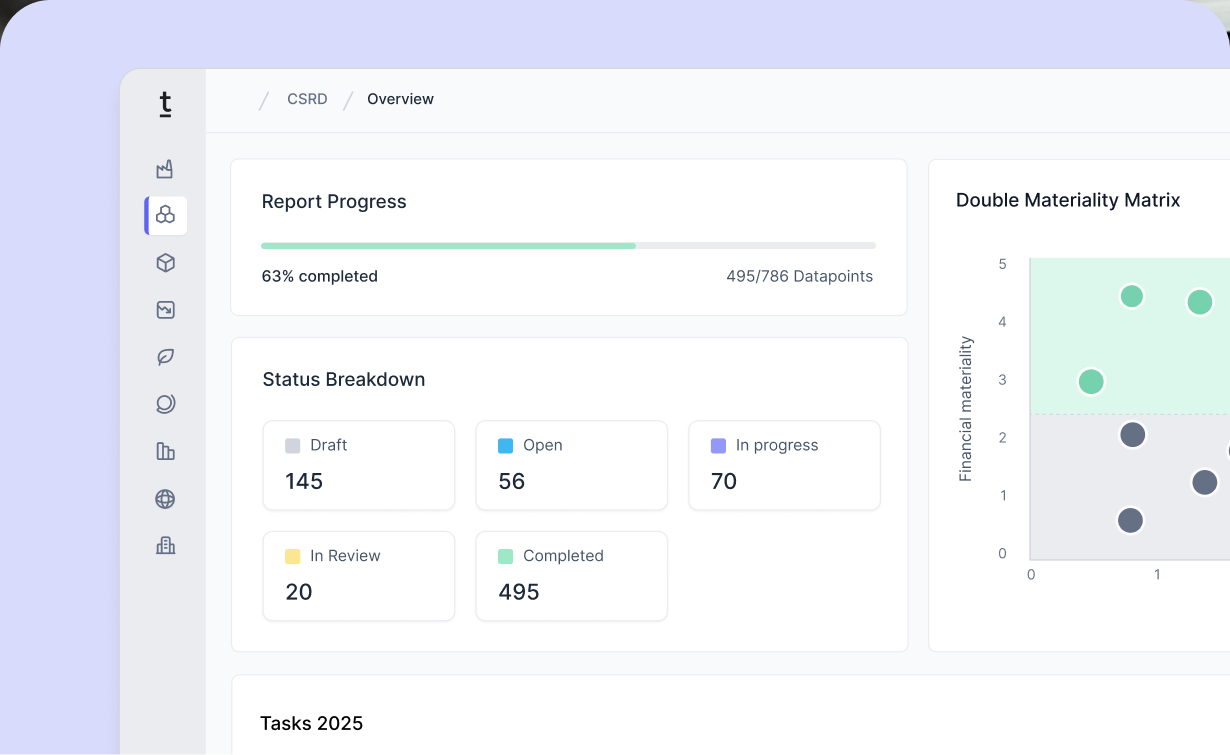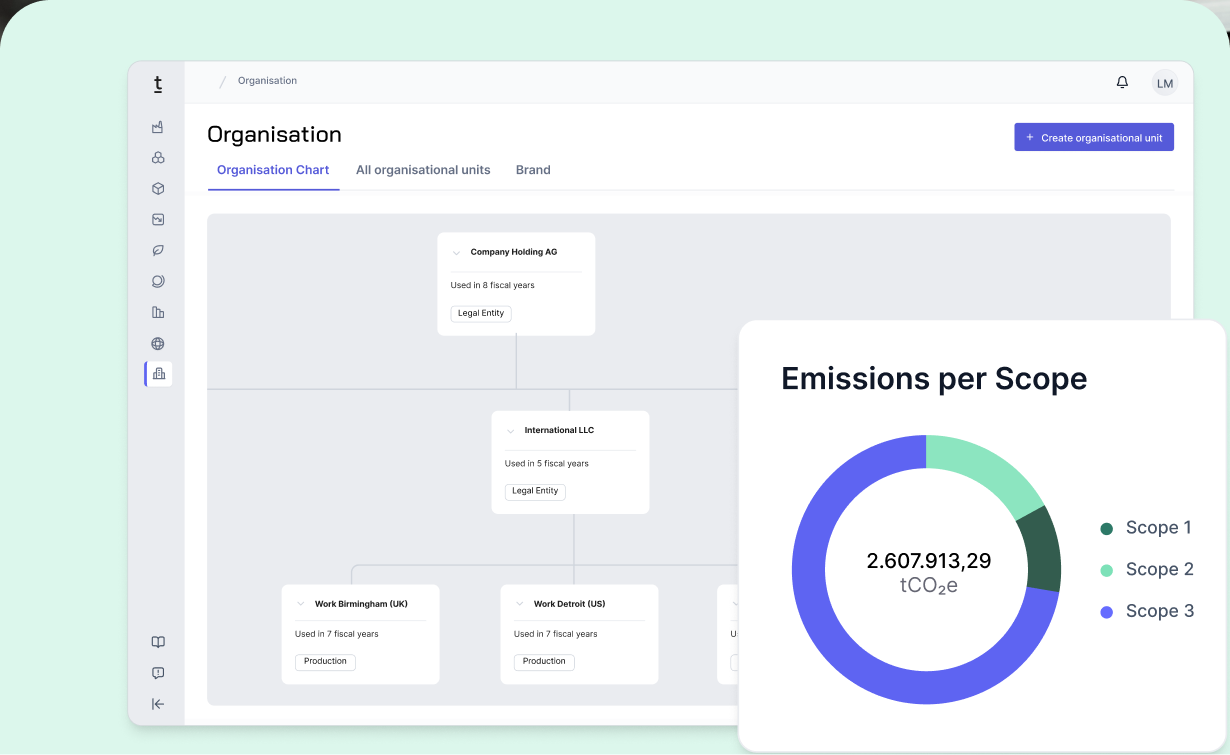Sustainability Reporting in the EU: Seizing Opportunities, Meeting Challenges and Shaping the Future

Sustainability reporting is a key element of modern corporate governance that creates transparency, builds stakeholder trust and ensures competitiveness. With increasing regulatory requirements such as CSRD, the importance of reporting will continue to grow. Companies need to address the challenges of data collection and compliance, and software solutions play a critical role.
Successful examples from companies such as Lenzing, Ottobock and Lundbeck show how sustainability can be strategically integrated and effectively communicated.
What is Sustainability Reporting?
Driven by initiatives such as the European Green Deal, sustainability reporting has become a central element of modern business management. It is not only about meeting legal requirements, but also about creating transparency, building stakeholder trust and ensuring long-term competitiveness. Companies are increasingly under the scrutiny of regulators, investors and the public, who expect clear information on environmental and social impacts.
As part of environmental, social and governance (ESG) reporting, sustainability reporting documents a company's environmental, social and governance activities and assesses their impact. It supports the goals of the European Green Deal to make Europe carbon neutral by 2050. By linking to the United Nations Global Sustainability Goals, it plays a central role in promoting sustainable development worldwide.
What is the European Green Deal?
The European Green Deal is an EU initiative that aims to make Europe climate neutral by 2050. It includes measures to reduce greenhouse gas emissions, promote the circular economy and preserve biodiversity. The Green Deal is the basis for far-reaching legislation affecting all sectors of the economy.
You can find all the relevant terms and their meanings in our sustainability glossary.

Opportunities and Benefits of Sustainability Reporting
- Create transparency and build trust: Sustainability reports provide clear information about a company's environmental and social practices. This transparency is essential for investors, customers and regulators to make informed decisions. Well-structured reports build stakeholder trust by demonstrating responsibility and commitment to sustainability.
- Improve market position and competitiveness: In a marketplace that is increasingly focused on sustainability, proactive reporting helps to differentiate and create new market opportunities. Investors and customers prefer companies with sustainable practices, ensuring long-term competitiveness.
- Improve risk management: Sustainability reporting is an effective way to identify environmental and social risks and take action to mitigate them. This enables companies to respond flexibly to regulatory changes and increasing stakeholder expectations.
- Other benefits: In addition to strengthening image and market position, sustainability reports promote efficiency by exposing weaknesses and stimulating innovation. They also facilitate access to capital, as sustainable investments are increasingly in demand, and attract new employees through a positive reputation.

Sustainability Reporting Challenges
Despite the many benefits, companies face a number of challenges when it comes to sustainability reporting. These barriers can make it difficult to implement reporting and reduce opportunities if not addressed.
- Complexity of Data Collection and Processing: Collecting and processing large volumes of data from different parts of the organization is a significant challenge. To be credible, this data must be prepared consistently and in accordance with reporting standards. Without effective data management, transparency and stakeholder confidence can be compromised, weakening market position. To avoid this, companies should invest in robust data processes and foster cross-departmental collaboration.
- Comply with multiple regulatory requirements: Companies in the EU need to prepare for compliance with regulations such as CSRD and ESRS, which, while uniformly regulated, come into force at different times depending on company size and industry. These requirements are time- and resource-intensive, which can limit a company's flexibility and reduce its ability to compete. However, with early planning and the use of specialized software, companies can increase their efficiency while meeting regulatory requirements, giving them a strategic advantage.
- Lack of standardized processes: Lack of standardized processes: A lack of standardization makes it difficult to compare sustainability reports and can lead to inconsistencies that can affect credibility with investors and other stakeholders. Companies that adopt standardized processes and established frameworks, such as this GRI standard, can overcome this hurdle. In doing so, they not only improve the quality of their reports, but also their efficiency and credibility, which strengthens their market position in the long term.
Regulatory Framework for Sustainability Reporting in the EU
CSRD (Corporate Sustainability Reporting Directive)
The CSRD is the central regulation for sustainability reporting in the EU and significantly expands the previous requirements of the Non-Financial Reporting Directive (NFRD). It expands the scope of companies required to report and increases the content requirements. Companies must provide detailed information on their sustainability strategies, risks and results. To meet these requirements, companies should optimize their data management processes and ensure that they have the necessary IT infrastructure in place.

ESRS (European Sustainability Reporting Standards)
The ESRS specify the reporting requirements of the CSRD. They specify what specific information companies must disclose in their reports and how they should be structured to ensure transparency and comparability. The standards are effective from January 2024 and require careful preparation to ensure that all relevant data is fully and accurately captured.
Additional regulations
Depending on the industry and business model, companies also have to comply with other regulations:
- CSDDD (Corporate Sustainability Due Diligence Directive): Requires companies to conduct human rights and environmental due diligence in their supply chains.
- LkSG (Supply Chain Due Diligence Act): Complements the CSDDD and aims to prevent human rights abuses and environmental degradation in supply chains.
- EU-Taxonomy: A classification system for environmentally sustainable economic activities that helps companies classify their economic activities. Learn more about the EU Taxonomy!
- CBAM (Carbon Border Adjustment Mechanism): Taxes imports from countries with lower climate change requirements to avoid distorting competition. Learn more about CBAM here!
- SFDR (Sustainable Finance Disclosure Regulation): Requires financial market participants to disclose how sustainability risks are factored into their investment decisions.
For an overview of the different sustainability reporting standards, click here.
How do you create a sustainability report?
Creating a sustainability report requires careful planning and precise execution to effectively capture and communicate all relevant information.
Steps to create a sustainability report:
- Set goals and scope: Identify the key sustainability issues and define the target audience. This includes environmental, social, and governance (ESG) issues.
- Collect data: Collect qualitative and quantitative data from various business areas that reflect sustainability performance.
- Data Analysis and Preparation: Analyze the data, identify trends and prepare the information in an understandable way.
- Verification and validation: Verify the data internally and externally, as necessary, to ensure the accuracy and completeness of the information.
- Develop a reporting structure: Create a clear structure that includes an introduction, strategy overview, and detailed reports on each topic.
- Writing and design: Make the report clear and appealing, adding visual elements such as charts and tables.
- Final content review: Finally, review the report for coherence and consistency. Ensure that all information is accurate and that the report meets the established objectives and scope.
- Publication: Make the report available online and in print in an accessible format.
Best practices and common pitfalls:
- Plan early: Start early to allow time for data collection and analysis.
- Clarity and understandability: The report should be clear and concise to avoid misunderstandings.
- Transparency: Be open about challenges and weaknesses to build credibility.
- Stakeholder engagement: Involve relevant stakeholders in the process to meet their expectations.
- Continuous improvement: Use lessons learned from past reports to improve future reports.
Avoid incomplete data, lack of consistency, and lack of connection to business strategy to ensure report quality.
Software and tools to support sustainability reporting
The use of software solutions such as Tanso makes reporting much easier. These tools help collect and analyze data and ensure compliance with regulatory requirements.
Why is software becoming increasingly important for sustainability reporting?
As demands and data complexity increase, software becomes more and more essential. It makes it possible to efficiently manage large amounts of data and produce accurate and consistent reports. The importance of digital tools will continue to grow, as they not only help companies achieve their sustainability goals more efficiently and increase transparency, but also improve audit assurance and reduce audit costs.
Examples of Sustainability Reports
Sustainability reports from established companies provide valuable insights and best practices that can be useful to small and medium-sized enterprises (SMEs) in the manufacturing sector. Below are a few examples:
- Ottobock
- Classification: Ottobock is a leading global medical technology company with a focus on prosthetics, orthotics and mobility solutions. Ottobock's sustainability report focuses on promoting recycling and reducing CO2 emissions. The report shows how the company integrates sustainable production processes and assumes social responsibility, which makes it particularly relevant for the medical technology industry.
- Link to the report: Ottobock Sustainability Report
- Lenzing
- Classification: Lenzing is a global leader in sustainable fibers for textiles and nonwovens. Lenzing's Sustainability Report focuses on the integration of sustainable practices along the entire value chain. The report highlights advances in circular economy and carbon reduction, making it particularly valuable for companies focused on sustainable raw material sourcing and production.
- Link to the report: Lenzing Sustainability Report
- Lundbeck
- Classification: Lundbeck is a biopharmaceutical company focused on neurological and psychiatric diseases. Lundbeck's sustainability report focuses on advancing neurological and psychiatric health worldwide. The report highlights initiatives to reduce carbon emissions, promote diversity and inclusion, and strengthen ethical business practices. Particularly relevant for companies in the healthcare sector.
- Link to the report: Lundbeck Sustainability Report
The Future of Sustainability Reporting
Sustainability reporting has become an indispensable part of modern business management. Its importance will continue to grow with increasing regulatory requirements such as CSRD and growing stakeholder expectations. Companies that act proactively can not only comply with legal requirements, but also strengthen their market position and gain the trust of their stakeholders.
The growing importance of digitization
As the complexity of reporting increases, so does the role of digital solutions. Software solutions enable the efficient collection, analysis and reporting of sustainability data and help companies comply with regulations. In the future, digitization will become even more important as it supports data-driven decisions and increases flexibility to respond to new challenges. Companies that integrate digitalization into their reporting processes early will be more successful and competitive in the long run.















































.avif)







.jpg)
.jpg)




















-p-800.webp.avif)
-min-p-800.webp.avif)






-p-800.webp.avif)

